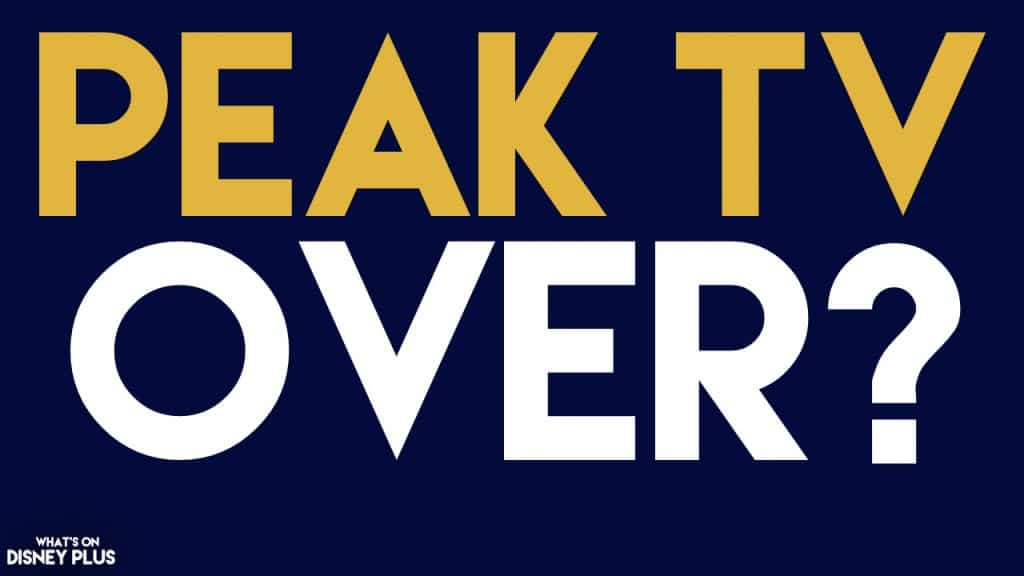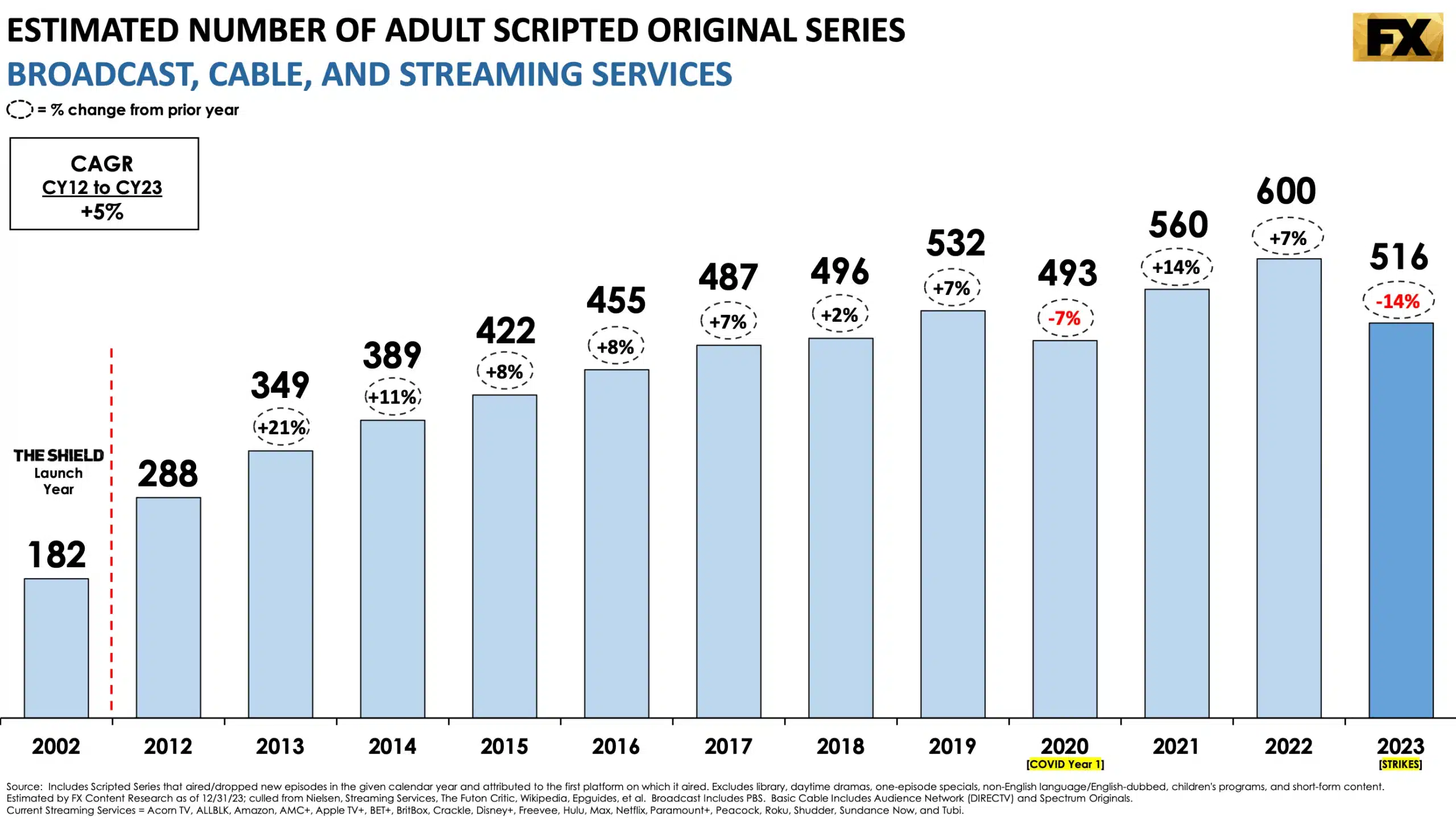
FX Boss John Landgraf Says Peak TV Is Over
Every year, at the Television Critics Association Press Tour event, the head of Disney’s FX studios, John Landgraf, shares an update on the current state of adult scripted original series being created for television, giving an overall impression of the industry as a whole across broadcast, cable and streaming services.
Over the last decade, the number of scripted shows has generally continued to increase, year on year, except for 2020, due to the pandemic causing chaos within the industry as production was shut down for months due to lockdowns.
In 2022, scripted shows reached over 600, and for years, John Landgraf has said that we would be soon hitting the peak TV era, where we might top out at how many scripted shows created for adults are created. With all the studios creating content for their streaming services, plus a buying feast by streaming platforms and broadcasters to get more content for people to watch, the number of shows has continued to grow.
However, 2023 was the first big decline in the overall number of adult scripted original shows, dropping 14% from 2022. There is no doubt that the actor’s and writer’s strikes, which caused production on many shows to halt for months, were a major reason for the reductions, but there are many other factors at play.
Once Wall Street flipped its approach to how it looked at streaming services, instead of focusing on subscriber number growth, to focus on profitability, making more original programming to get the attention of as many non-subscribers as possible was no longer the number one goal.
Disney is also going on a major cost-cutting measure to reduce the amount of general entertainment content it creates for its streaming services and linear channels. Along with other studios such as Warner Brothers Discovery and Paramount also pulling back on spending, it’s likely we will see a further reduction of original programming in the future.
And you only need to look at the sheer number of cancellations across all of the different studios, including Netflix, Warner Brothers Discovery, Comcast, and Paramount. Disney has also gone on a purge of cancellations in the past year with shows like “American Born Chinese”, “Willow”, “Station 19”, “Big Shot”, and many more.
FX’s John Landgraf was asked about when the turning point for the change was, to which he replied to THR:
The inflection point was when Netflix decided to change their public-facing Wall Street metric from global subscribers and ARPU [average revenue per user] to profit. I think they did that because they were ahead of everyone else and it was to their advantage to choose a metric in which they had the lead. And it not only benefited them, but all the other companies that were further behind were put into a significant amount of duress. And they had more than a decade of leeway basically to spend at a loss in order to cross the moat and be able to build scale before they achieve profitability. And unfortunately, the other companies have not been afforded that opportunity. So trying to get to profitability faster, you can definitely do things well. Netflix is very good at what they do; they’re very good at technology and customer acquisition and programming and many things. And you can definitely try to get there. But remember, it took them a long time to scale up and they were a first mover. There are a lot of things you cannot do very quickly. The only thing that you can do to get closer to profitability faster is reduce your output. It’s cut costs. Everyone has had to do that, by the way.
He was also asked what might help stop the contraction of original adult scripted programming.
A stabilization of the number of successful streamers at a profitable level, all of whom are in an ecosystem and competing with each other. What made Hollywood stable was that there were a number of very long-term, very successful companies, and they fought like cats and dogs with each other, but they also acknowledged each other’s existence and they were capable of selling to each other. The original Shogun was a CBS production for NBC as a broadcast network. I think it’s harder to sell to other companies when there isn’t any kind of stasis and there’s no knowledge that all these participants in the ecosystem will continue to exist. There are more streaming services than the market can bear. Now, I have no idea how they become less; I don’t know if it’s a commercial bundling arrangement. It’s just happened with the sports joint venture that Disney, Fox and Warners just announced.
Whether anything like that is possible or whether it has to do with mergers or consolidation or companies being broken up, there are just not going to be seven or eight or nine or 10 or 12 or 15 profitable streaming services. There are going to be four or five or six or three, I don’t know. And ultimately, once we have arrived at that state, then each of those will have some knowledge of their business and will achieve some sort of stasis. And then those entities will still try to compete with each other and try to gain advantage and gain market share. But I have no idea how long it’ll take to get there and even what the final state will be. But that’s what it’s going to take. We’re a long way away. I have no idea what the pace of decline will be or what the floor will be.
In the past year, we’ve seen plenty of consolation within the streaming business, with HBO Max merging with Discovery+ and Showtime with Paramount+, and we are currently in the early stages of seeing Hulu merge into Disney+.
Ultimately, there are only so many streaming services that people will subscribe to. Plus, with the studios sharing more of their originals between linear and streaming platforms, there is less need for as many shows. With Hulu On Disney+ being able to take advantage of all the ABC and FX shows, it just doesn’t need as many exclusive originals.
There are certainly going to be fewer adult scripted originals being created, but hopefully, we are likely to see a strong lineup of programming and fewer titles being cancelled after one or two seasons due to poor viewership. As with fewer original shows, the viewership will be spread out among the other shows that have been created.
In the past year, we’ve seen the number of Disney+ and Hulu Originals drastically reduce, and that’s likely to continue, especially as the two platforms become more intertwined in the US like they are internationally. The sheer number of original scripted shows being created in the build-up of the streaming wars was simply unstainable, and now the amount of shows is moving back to a more realistic number, and it’s likely it will continue to drop in 2024.
Do you think we’ve reached Peak TV? Let us know on social media!

